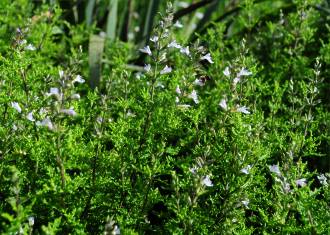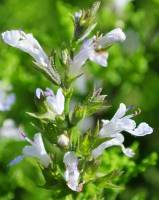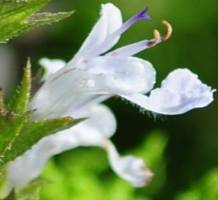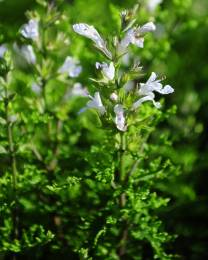Salvia namaensis
Salvia namaensis Schinz
Family: Lamiaceae
Common names: Nama sage (Eng.)
Introduction
The petite pretty flowers and water-wise, hardy nature of Salvia namaensis will add herbaceous charm to any garden.

Description
Description
Salvia namaensis is a fast growing, well branched, semi-woody herbaceous perennial shrub, 0.3-1.2 m high. It has upright, neat growth. The stems are square, which is characteristic of the sage family. The leaves are split into more than three lobes, with a large rounded terminal lobe and smaller lateral lobes which diminish in size towards the base of the leaf (lyrate-pinnatifid). They have a wrinkled look and are usually more rounded than flat. Both young stems and leaves are covered in glandless, fine, curled, dense hairs and oil globules. Leaves are covered with these hairs, but more densely below than above. The foliage is aromatic. Old woody stems are hairless. Within the species the size and shape of leaves are very variable.


Left: Salvia namaensis flowering stem Right: Salvia namaensis flower
Flowers are produced in whorls, at intervals along flowering stems which have floral leaves. These floral leaves are long and gradually taper to a sharp point (lanceolate-acuminate). The flower is typical of sage with a two-lipped corolla. The upper lip is hooded and houses the stigma and anthers, while the lower lip is cupped with the edges turned downwards, providing a platform for pollinators. The Nama sage's lower corolla is deeply cleft into two parts near the middle. The degree of exsertion of the stamens is variable within the species. Petite whitish to pale blue flowers are borne in spring and summer.
Black or dark brown, shiny nutlets (1.5mm) are visible at the base of the calyx and fall out when ripe. These seeds become sticky when wet.
Conservation Status
Status
Salvia namaensis is not threatened.
Distribution and habitat
Distribution description
The Nama sage occurs at the edge of the Little Karoo in the Anysberg, across the southern regions of the Karoo to Queenstown in the Eastern Cape; and up through the Great Karoo to the Free State, Fauresmith. It is also recorded from Namibia and Botswana. It occurs at altitudes of 400-1700 m in well drained, rocky or sandy soil on limestone and dolerite hills. It has been found along water courses.
Derivation of name and historical aspects
History
Pliny the Elder, a Roman scientist and historian, was the first to use the name Salvia.
The virtues of sages have been extolled in old herbal woodcuts and engravings of medieval and Renaissance Europe, giving medicinal recipes or describing charms or spells.
Salvias have been popular since the 1970s for ornamental gardening.
The name Salvia is presumably derived from the Latin, salvus meaning uninjured, whole, safe, well or sound and salvere, to be in good health, referring to the medicinal value of the plants.
The epithet namaensis indicates that the species comes from Namaqualand, Namibia or the Northern Cape.
The synonymy of Salvia namaensis includes S. burchellii N.E.Br. var. burchellii and S. burchellii N.E.Br. var. hispidula Skan.
It is believed that when N.E. Brown described S. burchellii he was unaware of Schinz's species, as he did not mention it in his original description.
Salvia is the largest genus in the Lamiaceae family. The genus Salvia consists of approximately 900 species made up of annuals, perennials and shrubs. They are widely distributed around the world in warm temperate and tropical regions. Twenty-seven species are found naturally in South Africa. Noteworthy South African sages are Salvia africana-lutea, S. africana-caerulea, S. chamelaeagnea, S. muirii and S. disermas. Sages are commonly grown as ornamentals.
Ecology
Ecology
Bees, butterflies and other insects are attracted to Salvia flowers. The filaments of the stamens are hinged, which gives them mobility, allowing them to attach pollen to visiting pollinators.
Uses
Use
Most sages contain essential oils and have long been used in cooking and medicine all over the world. The aromatic leaves and flower tips of Salvia namaensi are traditionally used to treat various infections.
Growing Salvia namaensis
Grow

The Nama sage is used as a perennial for summer displays. Use its fresh lime green foliage as a backdrop or foliage highlight amongst other perennials or fynbos. It will make an attractive rockery specimen.
S. namaensis grows well in pots with well-drained composted soils.
Young plants are planted out at the end of spring. Salvia namaensis is easily combined with most flowering perennials such as Lasiospermum bipinnatum, Selago species and Osteospermum jucundum or succulents and species of Aloe. They also contrast well with fynbos elements such as Restionaceae, Proteaceae and Erica species.
The fast growing plants get untidy after 2-3 years and need to be pruned back hard or lifted and replanted.
Salvia namaensis requires full sun with good drainage. It will survive with little water but responds well to regular watering, especially in summer. No extra feeding is necessary for strong, healthy growth although an occasional foliar feed would do no harm and the plants will tolerate feeding with organic or chemical fertilizers.
Young plants are easy to propagate from seed, cuttings or division of the creeping rootstock.
Sow seeds in late spring and early summer into general potting soil mix. Seeds germinate quickly and seedlings can be transplanted into well drained potting soil once the first pair of true leaves appears.
Take semi-hardwood tip cuttings in spring and summer. Cuttings must be without a terminal flowering bud. Place in rooting medium, 50% fine milled bark and 50% polystyrene (perlite, vermiculite and peat are alternatives). Place under mist or enclose in plastic bag to retain humidity. Keep warm but out of direct sunlight.
The hairy and aromatic leaves do not have any major pest, although mealy bug can settle down near the base of stems and leaves.
References
- Fox, E.W. & Norwood Young, M.E. 1982. Food from the veld. Edible wild plants of southern Africa. Delta Books, Johannesburg.
- Hyam, R. & Pankhurst, R. 1995. Plants and their names, a concise dictionary. Oxford University Press, New York.
- Hedge, I.C. 1974. Revision of Salvia in Africa including Madagascar and Canary Islands. Notes from the Royal Botanic Garden Edinburgh 33(1).
Credits
Monique McQuillan
Kirstenbosch National Botanical Garden
September 2011
Plant Attributes:
Plant Type: Shrub
SA Distribution: Free State, Limpopo, North West, Northern Cape, Western Cape
Soil type: Sandy, Loam
Flowering season: Spring, Early Summer, Late Summer, Sporadic/All year
PH: Acid, Neutral
Flower colour: White, Mauve/Lilac
Aspect: Full Sun
Gardening skill: Easy
Special Features:
Horticultural zones











Rate this article
Article well written and informative
Rate this plant
Is this an interesting plant?
Login to add your Comment
Back to topNot registered yet? Click here to register.